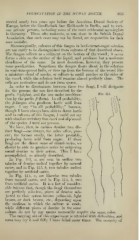Page 793 - My FlipBook
P. 793
FERMENTATION IN THE HUMAN MOUTH. 803
strated nearly two years ago before the American Dental Society of
Europe, before the Gesellschaft fuer Heilkuncle in Berlin, and to vari-
ous private persons, including some of the most celebrated mycologists
in Germany. Those who maintain, as was done in the British Dental
Association, that such cases may not be found, are responsible for their
own mistake.
J/ac/"oscopically, cultures of this fungus in beef-extract-sugar solution
are not easily to be distinguished from cultures of that described above.
The fungus collects as a sediment on the bottom of the vessel ; it never
forms a skin on the surface of the liquid, and produces but a moderate
cloudiness of the same. In most decoctions, however, they present
some peculiarities. Sometimes the fungus floats about in the solution
in semi-transparent balls, or rises up from the bottom of the vessel like
a miniature cloud of smoke, or collects in small patches on the sides of
the vessel, while the solution itself remains almost perfectly clear. The
cells are motionless and do not form spores.
In order to discriminate between these two fungi, I will designate
for the present the one first described by the
prefix .'/ (alpha), and the one under considera-
tion by the prefix /3 (beta). In all probability,
the /3-fungus also produces lactic acid from
sugar. I say " in all probability," because,
though I have always been able to detect lactic
acid in cultures of this fungus, I could not say
with absolute certainty that cocci and diplococci
of the species ./ were not present.
We have, then, in carious dentine two dis-
tinct fungi—one always, the other often, pres-
ent ; the former surely, the latter probably,
producing lactic acid from sugar. If these
fungi are the direct cause of dental caries, we
should be able to produce caries by subjecting
sound dentine to their action. This I have
accomplished, as already described.
In Fig. 413, a, are seen in outline two
tubules of dentine melted together by natural
caries, and in Fig. 413, 6, two tubules melted
together by artificial caries.
In Fig. 414, rt, are likewise two tubules
6, two
from natural caries, and in Fig. 41 4,
from artificial caries. It is a fact of consider-
able interest that, though the fungi themselves
are perfectly colorless, pieces of dentine sub-
jected to their action become yellowish, light
brown, or dark brown, etc., depending upon
the medium in which the culture is made,
while diiferent pieces of dentine in the same
culture do not by any means necessarily acquire the same, color.
The carrying out of this experiment is attended with difficulties, and
some may try it and fail ; I have failed many times. The necessity of


